Origins of
Kurzsignale 
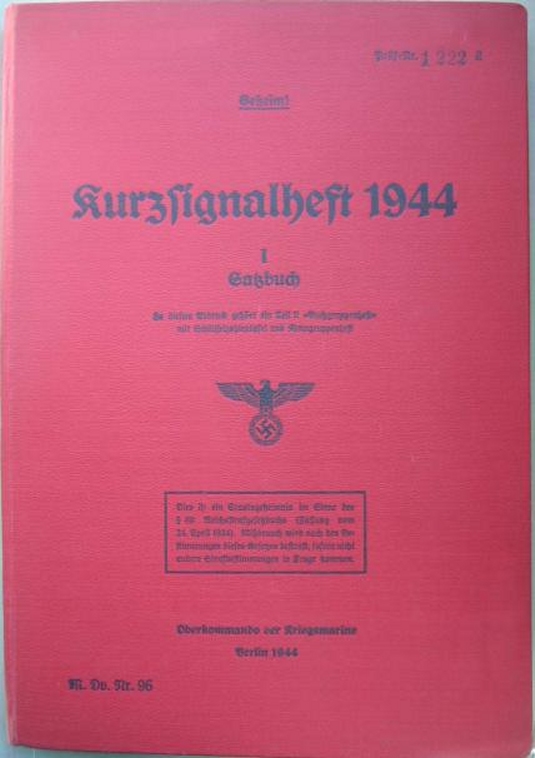 During the Second World War, the German U-boats
used Kurzsignale or Short Signals to send their messages.
The Kurzsignale were an important part of the complex
Kriegsmarine communications system. In general, the
Kurzsignale were four letter groups representing all
kinds of sentences regarding tactical information such as
course, enemy reports, position grids or weather reports.
During the Second World War, the German U-boats
used Kurzsignale or Short Signals to send their messages.
The Kurzsignale were an important part of the complex
Kriegsmarine communications system. In general, the
Kurzsignale were four letter groups representing all
kinds of sentences regarding tactical information such as
course, enemy reports, position grids or weather reports.
An important reason for the
Kriegsmarine to apply these Kurzsignale was the Allied
use of High Frequency Direction Finding, also called HFDF
or Huff Duff. This system enabled Allied Forces to
accurately determine the position of German
broadcastings. This was an important tactical advantage
in the Atlantic, revealing the positions of German ships
and U-boats. The use of Kurzsignale decreased the length
of the morse messages enormously, often reducing
broadcasting time to less than one minute. This way, the
German Navy made it harder to fix positions with Huff
Duff.
Kurzsignale on U-Boats 
The Kriegsmarine procedures on sending
messages with the Enigma cipher machine were far more
complex and elaborate than the Wehrmacht and Luftwaffe
procedures. Of course, secure communications were a most
vital part of the supremacy of the Kriegsmarine in the
Atlantic. The U-boats relied completely on secure
communications to receive their orders, coordinate
patrolling on sea, and their Wolfpack tactics. If the
communications were compromised, this would reveal
Germans naval positions and result in Allied tactical
countermeasures or active hunt on the U-boats.
During the War, several different
Kurzsignale methods were used on U-boats. Until 1942,
Alpha signals were used. An Alpha signal was a small
message, usually containing a single four-letter group.
From 1942 on, U-boats commonly used the Beta signals.
Various editions of Kurzsignalheft, the Short Signal
Codebooks, were applied during the war. Each Kurzsignal
message, or Beta signal, had a strict format, containing
an introduction, an identification to the key, and the
message, encrypted with the Enigma cipher machine.
The Codebooks 
To apply the Kurzsignale, the
Kriegsmarine used several different codebooks. The two
most important codebooks were the Kurzsignalheft for all
kinds of operational messages, and the
Wetterkurzschlüssel for weather reports. The
Kurzsignalheft contained tables that converted sentences
into four-letter groups. All kinds of expressions in many
different topics were listed. Logistic matters such as
refueling and rendezvous with supply ships, positions and
grid lists, names of harbors, countries, weapons, weather
conditions, enemy positions and ships, date and time
tables.
All possible situations and topics were
listed. Another codebook contained the Kenngruppen (key
identification) and Spruchschlüssel (start position
rotors at start of a particular message). The
Kurzsignalheft codebooks were printed on special paper
with red, water soluble, ink. If the codebooks were ar risk
of being captured, they were thrown them into the water.
Composition of the Kurzsignale 
In our example we will explain a Short
Message, encoded with the 1944 edition of the
Kurzsignalheft. This edition was more complex than the
previous. The Kurzsignalheft 44 consisted of two parts,
Heft I and II. Heft I contained the Satzbuch or sentence
book (phrases), to convert sentences into four-figure groups, and
the Schlüsselzahltafel or key number table. Heft II,
called Buchgruppenheft, was used to convert four-number
groups into four-letter words. In addition, to sign
messages or identify other U-boats in a message, the
Kriegsmarine used a codebook called Marinefunknamenliste
or Naval Callsign List. This was a list with all existing
U-boats and trigrams, three letter words, assigned to
each U-boat. Unfortunately for the Kriegsmarine, the more
complex 1944 edition didn't come into service on time to
change the odds for the decimated U-boat fleet in the
Atlantic.
The message that had to be sent:
GELEITZUG 16-20 DAMPFER
Quadrat CA 91 33 (CA 90 and 133)
U-999
|
Translated: Convoy of 16 to 20
steamships at Grid CA 9133, signed U-999
First, the three sentences are
converted into figures, using the Satzbuch:
GELEITZUG 16-20 DAMPFER = 0516
Quadrat CA 90 = 4545
133 = 8152
|
Next, a key number, retained from the
Schlüsselzahlentafel or key number table is added,
without carry:
0516 4545 8152
+ 0384 0384 0384
----------------
0890 4829 8436
|
Finally, the resulting figures are
translated into four-letter words with the
Buchgruppenheft, and the message is signed with the
trigram, representing our U-boat in the
Marinefunknamenliste:
0890 = ZLDP
4829 = OYAK
8436 = WIKW
U999 = LQX
|
Not only the Kriegsmarine transmission
procedures and message format were different from the
Wehrmacht and Luftwaffe. The key sheets for the Enigma
settings were also different. The Wehrmacht used one
table with rotors, ring settings, plugs for each day of a
given month. The Kriegsmarine used various code books and
key sheets. The Kriegsmarine TRITON key sheets consisted
of two parts.
The first sheet, called Schlüsseltafel
M Algemein - Innere Einstellung, contained the three
rotors and their ring settings, the thin beta or gamma
rotor and the reflector, and this for all odd days of a
whole month. The second sheet, called Schlüsseltafel M
Algemein - Aussere Einstellung, contained the plugs and
Grundstellung or start position for each day of the
month.
The Kriegsmarine Sonderschlüssel M,
used for private conversations between the Commander of
the U-Boat Fleet and a particular U-boat, had a special
key sheet with only three inner settings, and three
plugboard settings, each for a period of ten days, and a
list of Spruchschlüssel or message keys, designated by a
code word. The Sonderschlüssel M was similar to the
Schlüsseltafel M Offizier from TRITON. Examples of the
Kriegsmarine keys on the procedure page.
In order to prepare the message for
transmission, the operator had to encipher the message
with the Enigma cipher machine. The internal settings and
plugboard of the Enigma would already be set. The
operator selected a Kenngruppe and Spruchschlüssel from
his Kenngruppenheft codebook. A Spruchschlüssel or
message key was the initial start position of the Enigma
rotors prior to enciphering. The Kenngruppe was a trigram
to identify the Spruchschlüssel.
The kenngruppenheft was a fixed
codebook, which was not regularly replaced. It had three
parts: The first part is the Zuteilungsliste, a table
where you could find sets with ranges of numbers,
according to the day and radio net. Within a range that
was derived from the table, the operator selected a
figure. The second part was Teil A, where you could
look-up the figure and find the Kenngruppe and
Spruchschlüssel behind it.
The Spruchschlüssel was set as start
position on the Enigma and the Kenngruppe (in our example
RDF) was added (not encrypted!) at the beginning of the
message to identify the Spruchschlüssel. The receiving
operator would look-up the Kenngruppe in the third part
of his codebook, Teil B, and find the figure that was
related to that Kenngruppe. With this figure, he could
now find the appropriate Spruchschlüssel (message key)
to decipher his message.
An example of how the groups could be
enciphered with the Enigma:
The completed message contained the
following information:
a. The introduction signal ßß (beta
beta)
b. The Kenngruppe trigram, non-enciphered
c. All signal groups, enciphered
d. The signature, enciphered
e. The repeated non-enciphered Kenngruppe
The complete Kurzsignal message, ready
for transmission:
ßß
RDF
QRLZ ATMG SFPR
ODT
RDF
|
An experienced radio operator could
easily transmit this little message in morse in about 20
seconds.
At the end, the operator used 7 tables
or key sheets to encipher his message! The Kurzsignalheft
Heft I with its Satzbuch to convert
sentences into four-figure groups and the Schlüsselzahltafel
to add the key number, Heft II with the Buchgruppenheft
to convert the four-figure groups into four-letter
groups, the Marinefunknamenliste to
identify the U-boats, the two key sheets Schlüsseltafel
M for inner an outer settings of the Enigma
machine and finally the Kenngruppenheft
to select the message key. No wonder they were confident
their communications were secure. Nonetheless, Allied
codebreakers succeeded in breaking into the U-boats
communications as you can read in Enigma and the
U-boat War.
Some pages from the Kurzsignalheft
(click to enlarge).

Kurzsignalheft
|
|

Feindmeldungen
(Enemy Reports) |
|
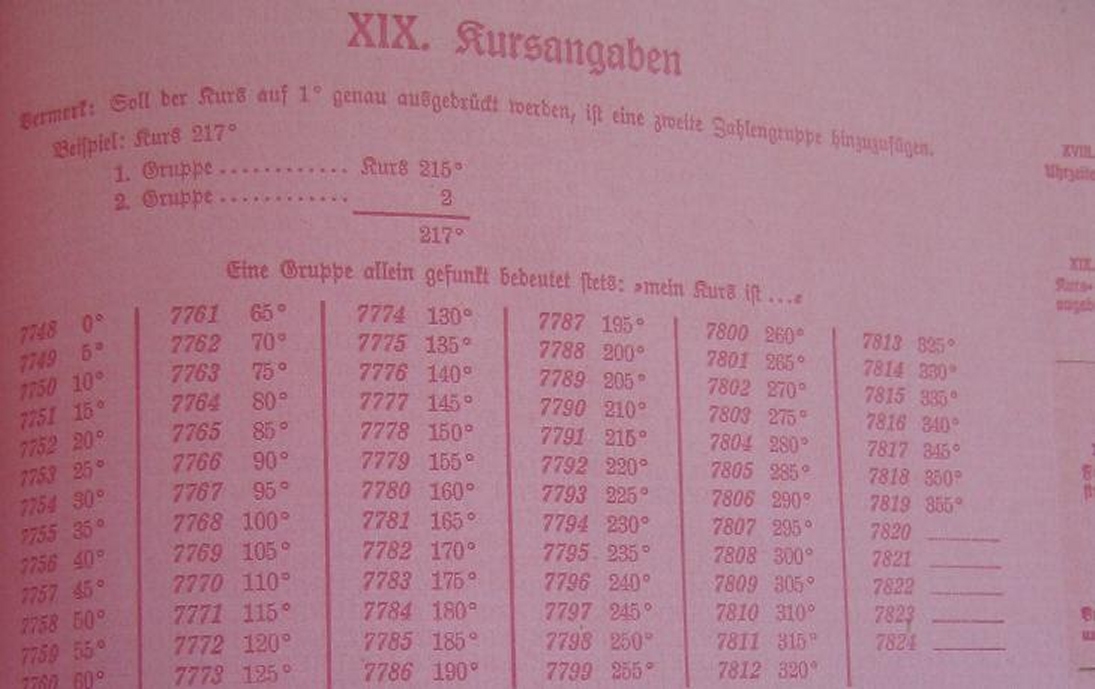 Kursangaben
(Course Data) |
|
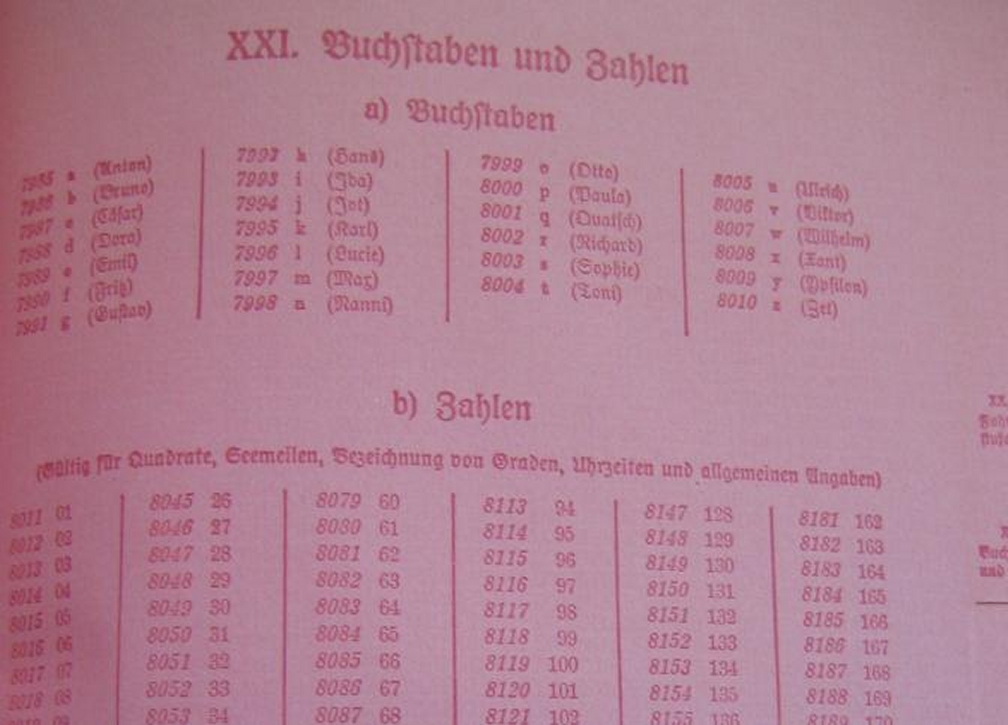 Buchstaben und Zahlen
(Letters and Numbers) |
|
Some pages of the Kenngruppenheft. The
Zuteilungsliste to select a figure, part A to find the
trigram and message key, and part B to return a trigram
into a figure (click to enlarge).
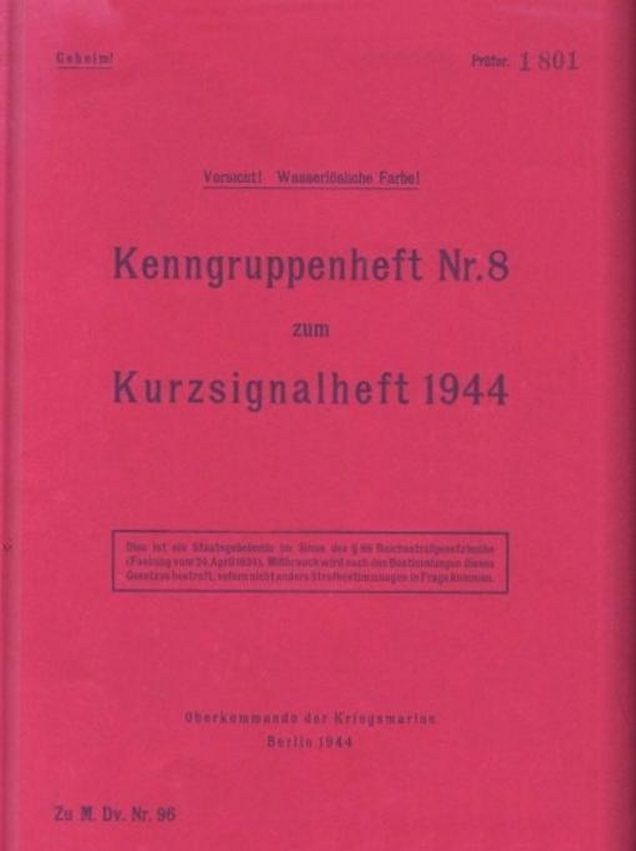
Kenngruppenheft
|
|
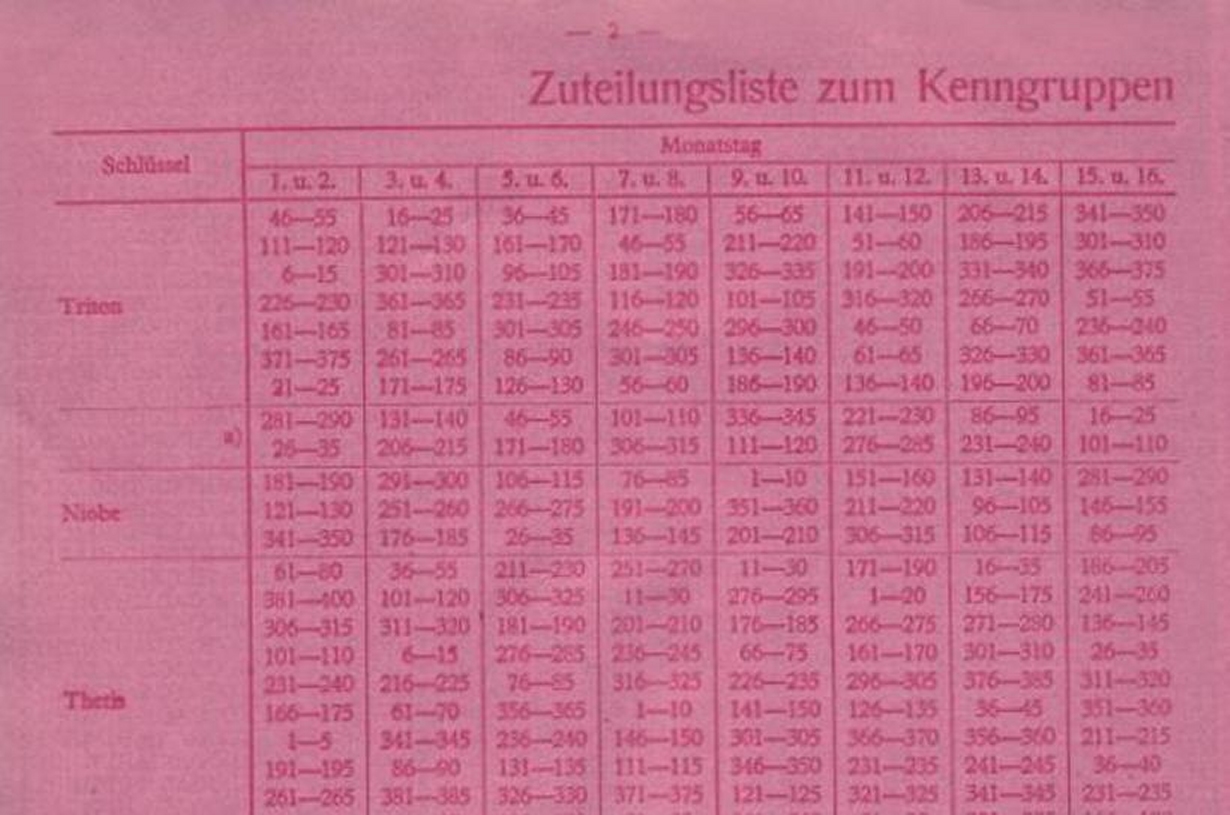
Kenngruppenheft
Zuteilungsliste |
|
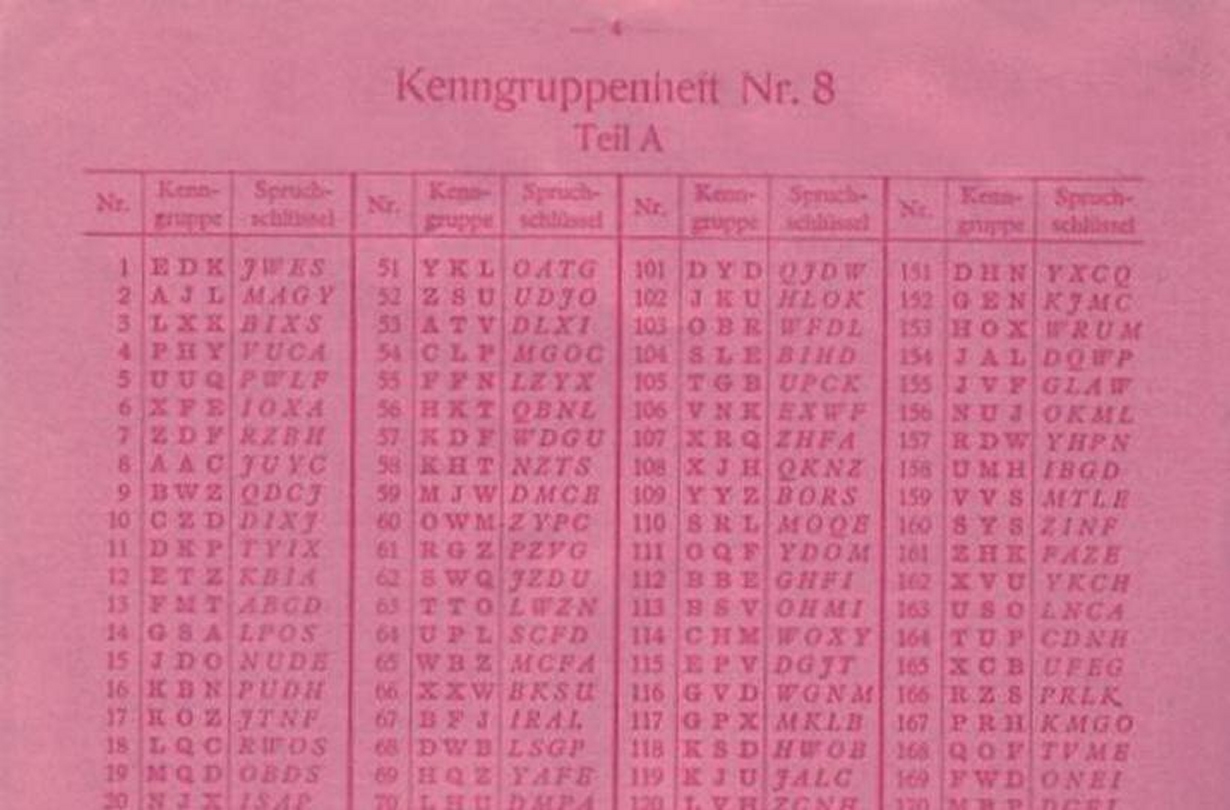 Kenngruppenheft
Teil A |
|
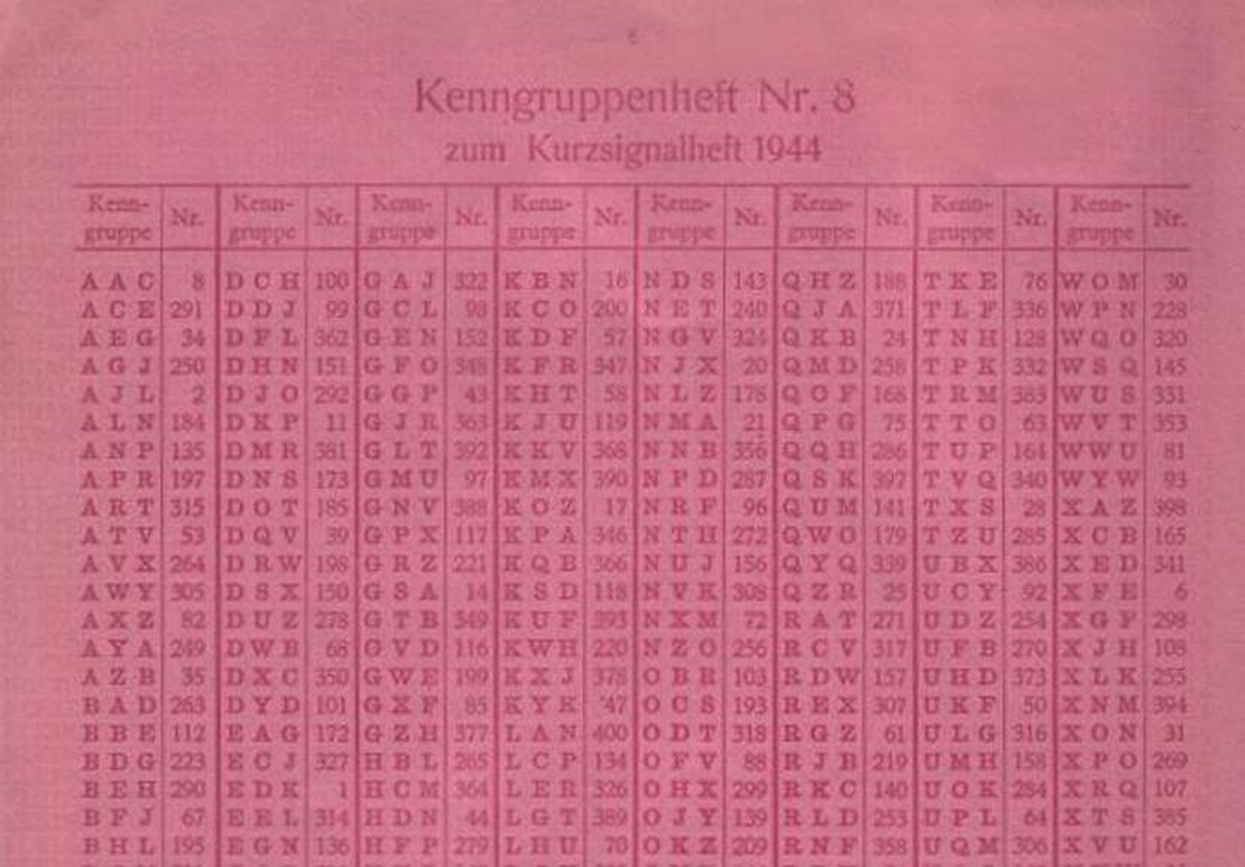 Kenngruppenheft
Teil B |
|
The Wetterkurzschlüssel 
Weather reports were vital tactical
information for the Kriegsmarine. Every few hours, the
U-boats had to send detailed weather reports by radio.
However, each broadcast from a submarine increased the
risk of detection by Allied direction-finding systems.
Therefore, it was important to put as much as possible
information into a message that was as small as possible
and the Wetterkurzschlüssel or WKS did just that.
Each Wetterkurzsignal consisted of 23
or 24 letters, representing a certain weather condition.
Thirteen tables determined which letter or letter
combination was used for a particular weather condition.
These included barometric pressure, clouds, winds,
visibility, rain fall and so on. Thanks to the
Wetterkurzschlüssel a large amount of weather variables
was compressed in only a few letters.
Format of a Wetterkurzsignal
Normal weather Ice weather
Sp R B B Sp R B B
P P P A P P P A
C W Z v C W Z v
D D D K D D D K
L T M G L T M G
U U U E U U U
Meaning of the Symbols
Sp= Identification of Wetterspruchschlüssel (message key)
R = Identification sea area (weather grid map) of the observer
and changes in wind direction during the last 3 hours
B B = Identification letters for the observation location
P P P = Barometric pressure in two millibars
A = Barometric pressure during the last 3 hours
C = Clouds
W = Sky covering and rain fall
Z = Weather change during the last 12 hours
v = Horizontal visibility and fog conditions
D D D = Wind direction and strength
K = Changes of wind strength, swell and height of the swell
L = Length and direction of the swell
T = Air temperature in whole degrees Celsius
M = Difference between air and water temperature
G = Time of observation in complete hours after DGZ
E = Ice conditions
U U U = Signature of U-boat
|
Some pages of the Wetterkurzschlüssell
book (click to enlarge).
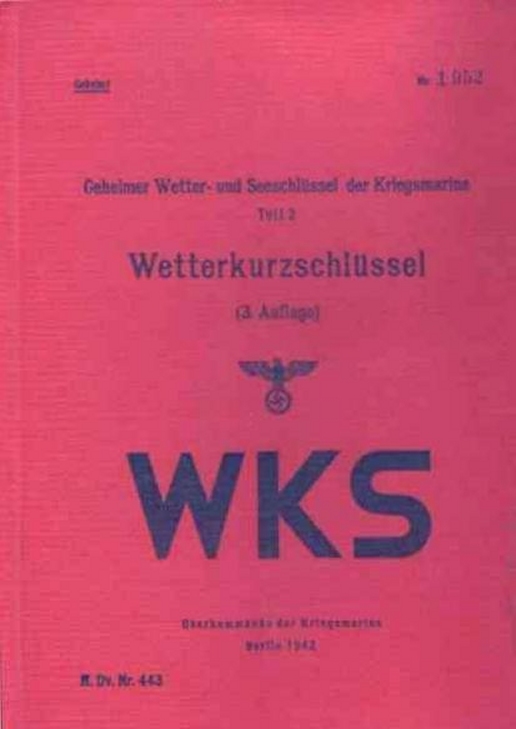
Wetterkurzschlüssel book |
|
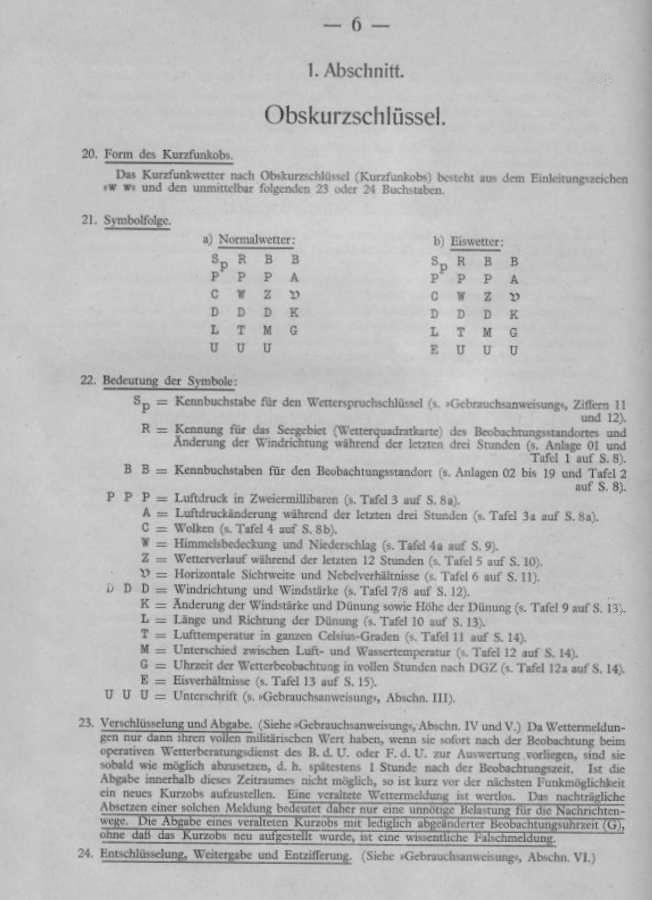
Wetterkurzsignal format |
|
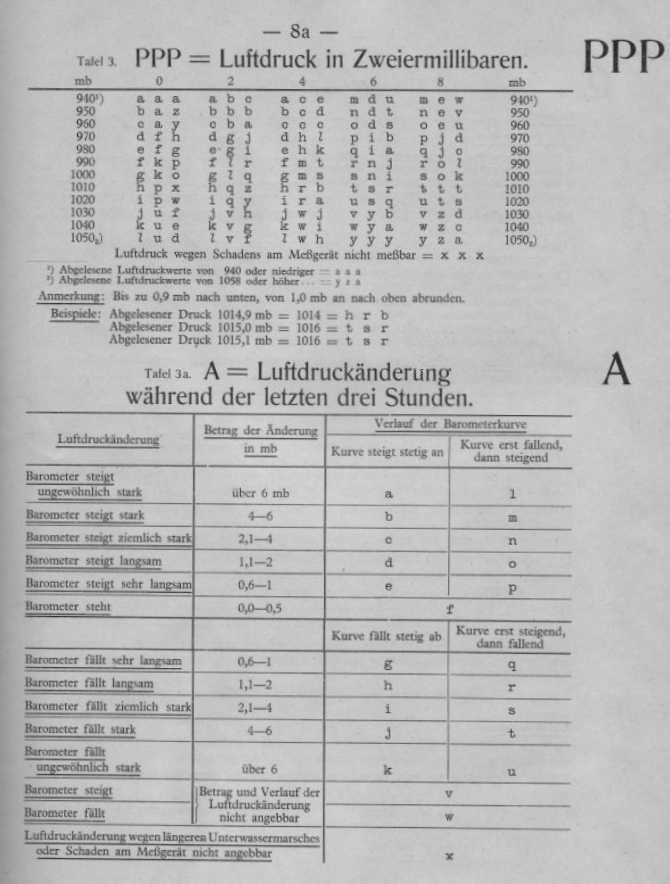 Barometric
pressure and changes |
|
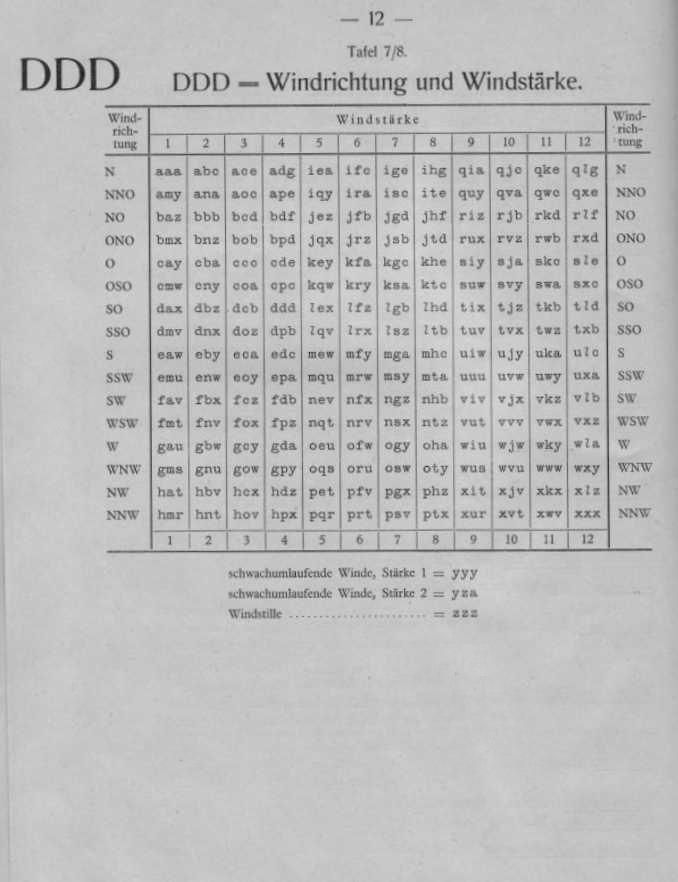 Wind direction
and strength |
|
The Kurier
System 
In August 1944 the Kriegsmarine began
testing an experimental system called "Kurier",
designed as a countermeasure against High Frequency
Direction Finding. It was a system, based on a principle
now known as burst-encoding. The Kurier device was
connected to a radio transmitter. The main component of
Kurier was the pulse generator KZG 44/2, a drum with 85
small adjustable bars. Each bar represented a signal
pulse. When started, an arm with a magnetic pickup
element made one single rotation, passing the 85 pre-set
bars. Each pulse was 1 millisecond long and there was a 3
millisecond gap between each pulse.
Together with start pulses and pauses,
the complete transmission of the short message never took
more than 460 milliseconds! The Kurzsignal that had to be
sent was converted into Morse code. Each dot was set on
the Kurier device as one pulse, a dash was two pulses.
Between dots and dashes there was a pause of one pulse
length, and between letters two pauses. The Kurier
receiver KGR-1 converted the pulses into a light beam
that was projected on a rotating drum with photosensitive
paper. More technical details on the Foundation for German
Communications and Related Technology .
.

Schematic example of a complete Kurier signal
reception ribbon
|
The Kurier system was to be used to
transmit Kurzsignale and Wetterkurzsignale, combined
with a complex schedule of frequency changes with
frequency shifts of plus or minus 200 KHz. Each Kurier
Wetterkurzsignal was seven letters long. Each letter of
the Kurzsignal stands for a value, obtained from a table
in the Kurier book. For instance: if the first letter of
the Wetterkurzsignal is G this means 1034 millibar. As
always with kurzsignale, each message was to be
enciphered with Enigma prior to transmission with the
Kurier device.
Composition of the Kurier
Wetterkurzsignal:
PDF WBBU
P Barometric pressure
D Wind directions
F Wind strength
W Clouds
BB Observation point (bigram table)
U Identification sea area (Weather Grid)
|
By the end of 1944 Berlin made the
Kurier tests a top priority, but the program was
interrupted before the Kurier system was operational on
the U-boat fleet. Events would finally catch up with the
program and the end of the war stopped further
experiments. Had the Kurier system been operational at an
earlier stage of the U-boat war, it could have resulted
in serious consequences. Allied intelligence would have
been deprived of direction finding and monitoring
Kurzsignal messages. This would not only mean loss of
U-boat positions but would also deprive the codebreakers
in Bletchley Park from the essential cribs to break the
Enigma keys, used to encrypt the Kriegsmarine message
traffic. This could have changed the outcome of the war
in the Atlantic.
Some pages of the Kurier
Wetterkurzsignal procedures. This book contained the
guidelines, frequency shift tables and the tables to
convert weather values in letters (click to enlarge).
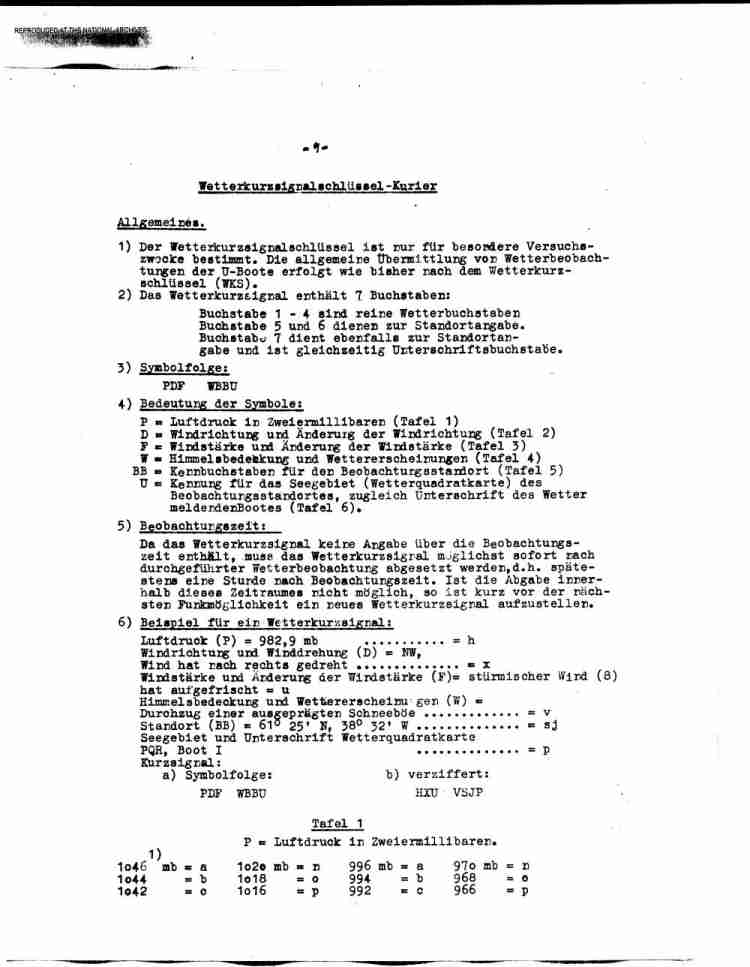
General
description |
|
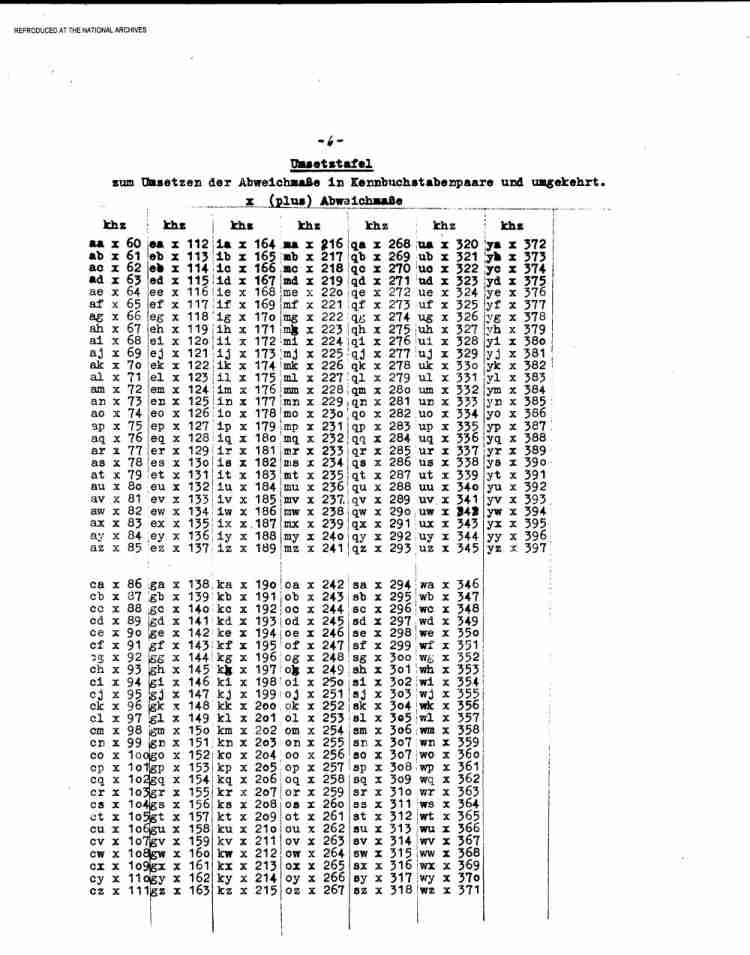
Frequency Shift
Tables |
|
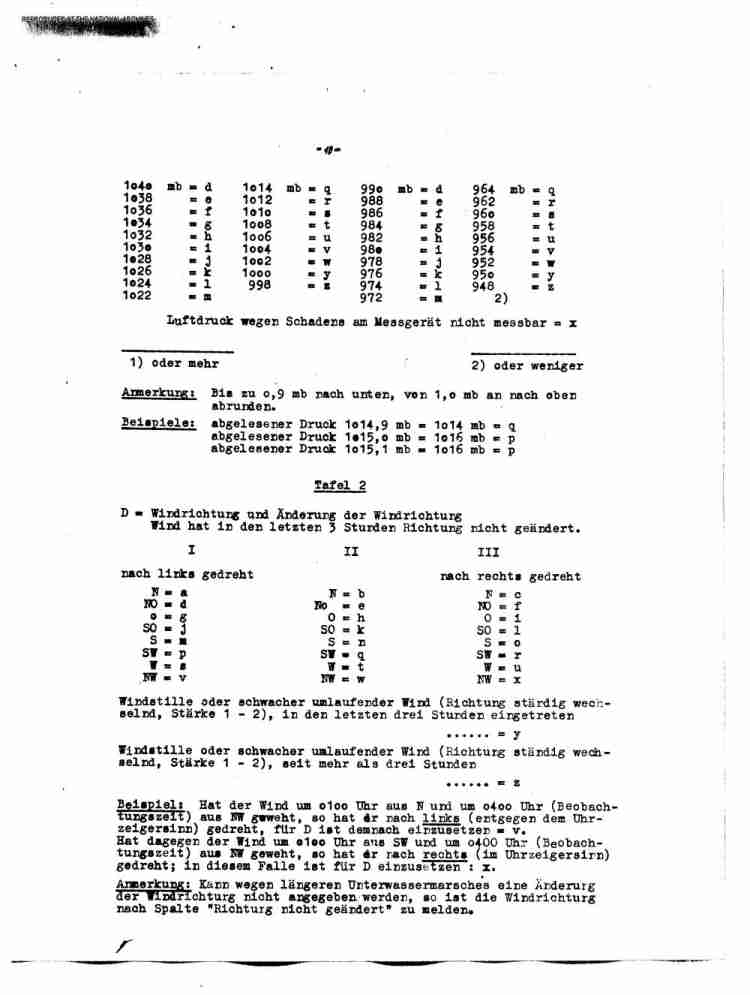 Pressure and
wind direction |
|
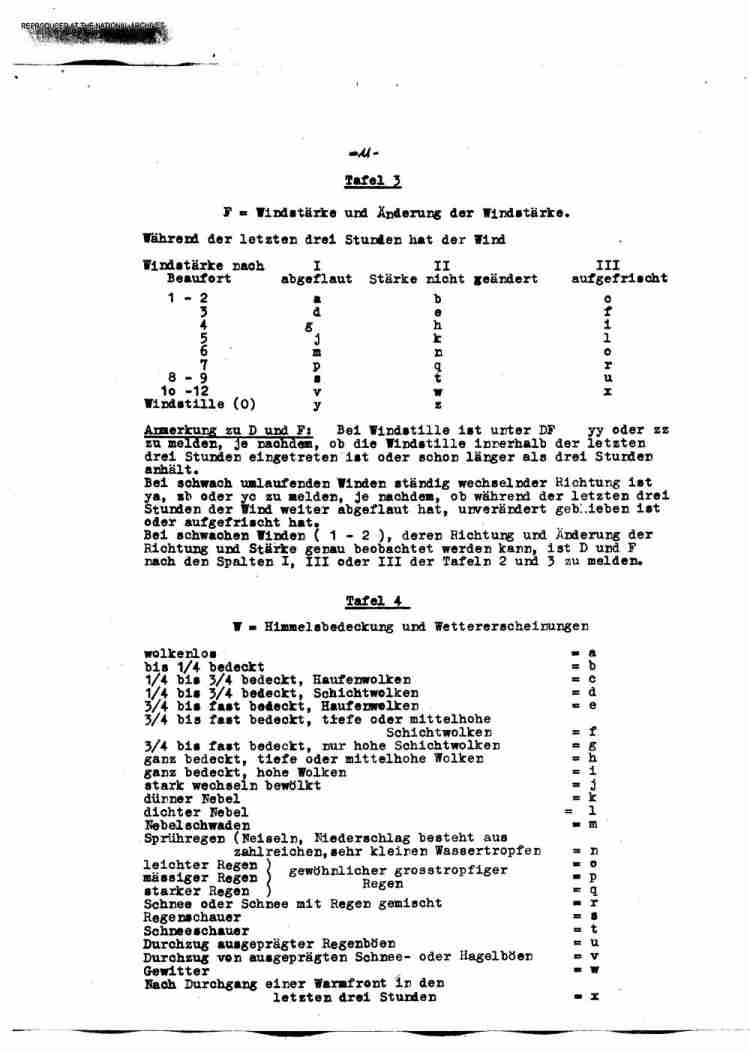 Winds
and clouds |
|
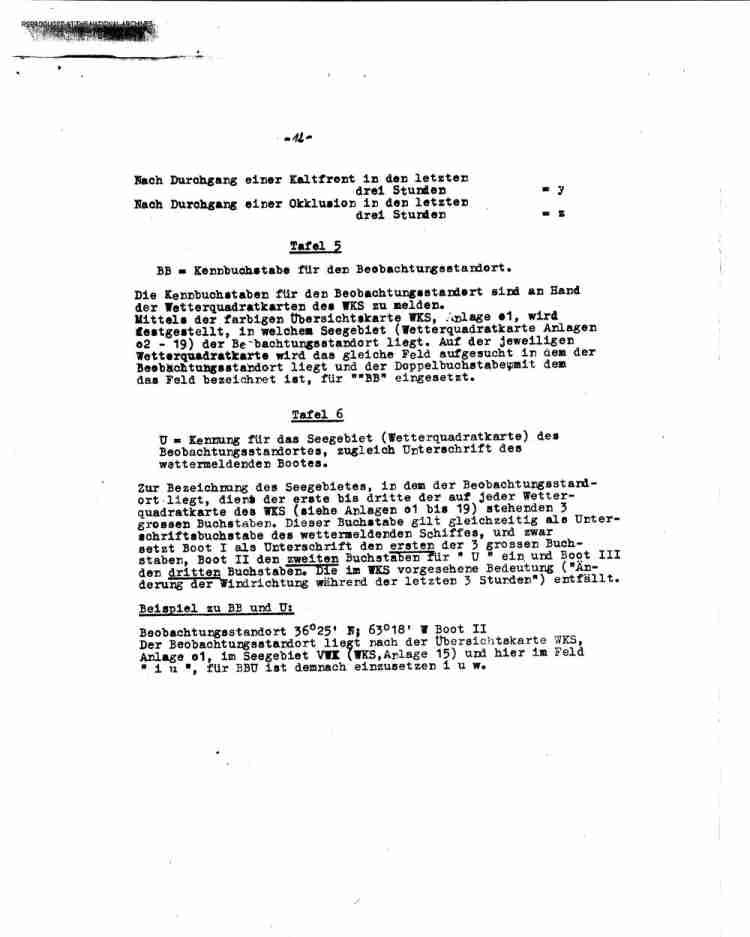 Observation
position |
|
More on this Website 
More Information (offsite,
opens in new tab)

















